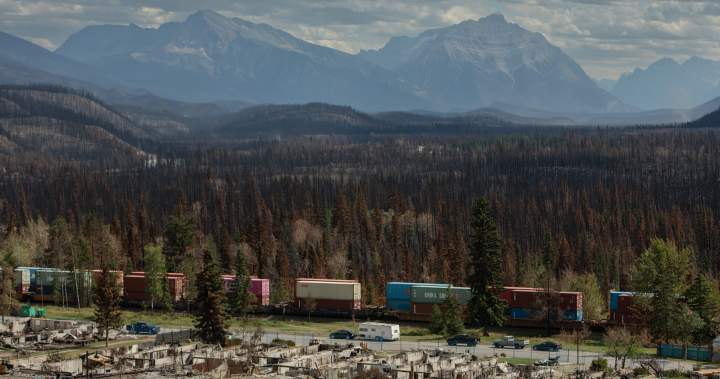As I walk down Connaught Drive in Jasper, the scent of fresh sawdust mingles with pine. Construction crews dot the landscape where charred foundations once stood—silent testimony to the wildfire that tore through this mountain community exactly one year ago.
“It’s a full box of emotions,” says Richard Ireland, Jasper’s mayor, gesturing toward a partially rebuilt home. “Progress feels simultaneously too slow and remarkably fast, depending on who you ask.”
The devastating wildfire that swept through Jasper National Park on July 22, 2023, destroyed approximately 30% of the town’s buildings, including more than 400 homes and numerous businesses. What followed has been a complex rebuilding process that offers lessons for communities across Canada facing increasing climate disaster risks.
Local business owner Sarah Mackenzie stands in her newly reopened gift shop, walls still smelling of fresh paint. “We reopened three months ago after operating from a food truck all winter,” she explains. “Some days I feel immense gratitude. Other days, when I look at empty lots where my neighbors’ homes stood, it’s overwhelming.”
According to Parks Canada‘s latest recovery report, approximately 118 residential rebuilding permits have been issued, with 73 constructions actively underway. Commercial reconstruction has moved somewhat faster, with tourism being the economic lifeblood of the community.
The recovery timeline reveals the complex reality of disaster rebuilding in Canada. Alberta Municipal Affairs reports that major infrastructure repairs are approximately 65% complete, but housing reconstruction lags behind at roughly 30%. These figures align with what disaster recovery experts consider typical—full community recovery often takes 3-5 years.
“We’re seeing a pattern consistent with other wildfire recoveries,” explains Dr. Emma Lawrence, disaster management researcher at the University of Alberta. “The emotional recovery timeline often doesn’t match the physical one, creating tension within communities.”
This tension is visible in town council meetings, where debates about building code changes and emergency preparedness measures have sometimes divided residents. Some advocate for stricter fire-resistant building materials, while others prioritize rebuilding quickly and affordably.
The financial toll remains substantial. The Insurance Bureau of Canada estimates total insured damages at approximately $760 million, making it one of Alberta’s costliest natural disasters. However, many residents discovered insurance gaps only after losing everything.
“My policy covered about 70% of what I needed,” says former hotel manager Tom Whitestone, now living in temporary housing. “Nobody expects to lose everything and then discover they can’t afford to rebuild the same home.”
Federal and provincial disaster assistance programs have provided approximately $240 million in support, but distribution has been uneven. Small business owners particularly report struggling with complicated application processes and delayed payouts.
The provincial government points to streamlined building permits and emergency funding as evidence of its commitment. “We’ve prioritized cutting red tape for Jasper residents,” said Alberta’s Minister for Municipal Affairs in a recent press conference. However, interviews with local officials suggest the bureaucratic reality remains challenging.
Perhaps the most remarkable aspect of Jasper’s recovery is the community resilience. The Jasper Strong fundraising initiative has raised over $2.8 million for families in need. Volunteer groups have constructed 12 temporary housing units, and neighboring communities continue sending support crews on weekends.
Tourism, crucially, has rebounded faster than expected. Parks Canada reports visitor numbers for summer 2024 are at approximately 85% of pre-fire levels. The Jasper Tourism Association launched an effective “Still Beautiful” campaign showing that while some areas were damaged, most of the park’s natural attractions remain intact.
“Visitors are our economic engine,” explains local tour operator Leanne Westerberg. “Each person who books with us isn’t just a customer—they’re helping rebuild our community.”
Climate scientists point to Jasper’s experience as increasingly relevant for communities nationwide. Environment Canada data shows wildfire risk zones expanding across the country, with seasonal danger periods lengthening by an average of two weeks compared to historical norms.
“What happened in Jasper isn’t an anomaly,” warns Dr. Carlos Menendez, climate adaptation specialist at the University of British Columbia. “We’re seeing conditions that make similar events more likely across previously low-risk regions.”
The rebuilding effort has incorporated some climate adaptation measures. New structures feature fire-resistant materials, and the municipal government has created firebreaks around critical infrastructure. Parks Canada has also revised forest management practices to reduce fuel loads near populated areas.
As the community marks this somber anniversary, Jasper’s experience offers both caution and hope. The physical rebuilding continues at a steady if sometimes frustrating pace. The emotional recovery moves along its own timeline.
“Some days I walk through town and barely notice what’s missing anymore,” says longtime resident Elaine Thompson, who lost her home but has since rebuilt. “Other mornings, I wake up disoriented, forgetting for a moment that everything changed.”
As Canada faces increasing climate-related disasters, Jasper’s recovery journey provides valuable insights into the long road from emergency response to true community restoration. It’s a path that requires not just financial resources but sustained emotional support, policy adaptation, and recognition that recovery isn’t measured in months but years.
For now, the sounds of construction continue along Connaught Drive—a persistent rhythm of hammers and saws that residents hope will eventually fade into the background of normal mountain town life.






